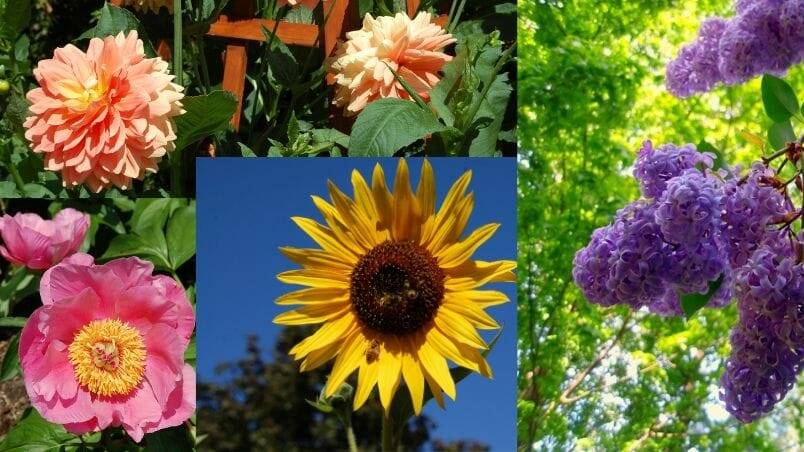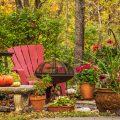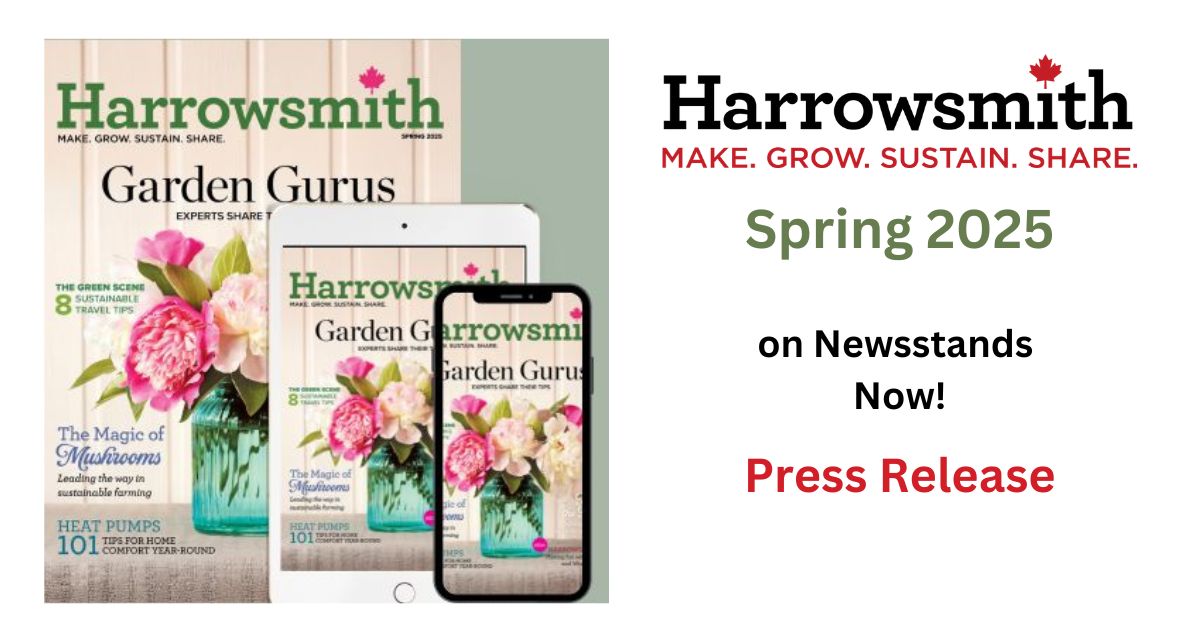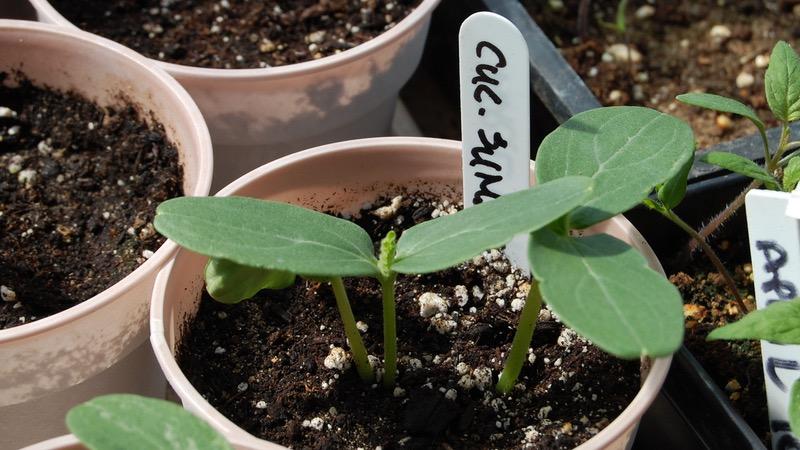“An acre of land between the shore and the hills…
A garden I need never go beyond,
Broken but neat, whose sunflowers every one
Are fit to be the sign of the Rising Sun…”
– Edward Thomas (1878–1917), “For These”
Shopping for garden plants is much like shopping for anything else: There are plants that provide great value and others that provide, well, not so much. In our books, the plants that put on the best show are worthy of our attention when we are looking over the inventory at a Canadian garden retailer — many plants provide a shot of colour that is paramount to fireworks in the garden. Here are some of our large-blooming favourites.
1. PEONIES What they lack in the length of their blossom time, they more than make up for with big colour! Mark has about 50 peonies in his garden, and he mark the beginning of the summer by their blossoms. Each one produces masses of soccer-ball sized (well, almost!) blooms that are suitable for cutting and bringing indoors. Many are fragrant as well. We find that peonies are relatively free of pests and diseases. They are extremely winter hardy to Zone 2, and when they are not in bloom, they produce clean, strong, dark green foliage that stands up to the summer heat.
Most of Mark’s peonies are Chinese, but he has a couple of Japanese tree peonies as well. They stand out for their tall, strong stems and outstanding colour selection. They only bloom for a few days, but they are more than worth the wait. They bloom just a few days before their herbaceous Chinese cousins, and we can recommend Japanese tree peonies to anyone looking for an exotic, winter-hardy perennial.
2. HYDRANGEAS The hydrangea species has undergone a renaissance in recent years, thanks to aggressive and very successful hybridizing. The large flowering, snowball-shaped Annabelle hydrangea (Hydrangea arborescens ‘Annabelle’) has been usurped by the Endless Summer series. Mark has the new ‘Incrediball’ hydrangea in his garden and he loves it. With large white flowers about the size of his head, even Tilley would have trouble finding a hat to fit this one. The length of the flowering period, from late July through early October, provides even better value for your bloom buck.
Mark replaced a mass planting of ‘Annabelle’ at the front of his house with ‘Limelight’ hydrangea a couple of years ago.. They bloom with more profusion, stand strong without staking, and look fabulous from early August through late October.
Truth is, all hydrangeas hold their flowers over the winter. Mark leaves his intact as fodder for foraging songbirds during the winter months. The spent flowers gather snow when it falls softly, adding some winter interest. He prunes his plants in spring, though not nearly as severely as he does the ‘Annabelle’ variety.
Cutting hydrangeas to enjoy indoors works very well. If you let the stems of the flowers stand in 2 cm (one inch) of water and allow the water to evaporate, the flowers will dry naturally and without any fuss. Hydrangeas equal perhaps the best value in the garden centre!
3. LILACS Not all large flowering plants are herbaceous perennials (i.e., ones that “die down” to the ground each winter). Lilac shrubs are a great Canadian family of plants that, if you play your cards right, will provide a sequence of colour for up to six weeks. Here’s how.
Common lilac (Syringa vulgaris). This is the workhorse of lilacs. Very winter hardy even on the coldest part of the Prairies. Syringa vulgaris is one tough customer that has very few complaints in a sunny garden. Blooming from mid- to late May each year, it is the first of many lilacs to produce colour each spring. Fragrant and suitable for cutting. But this plant can be aggressive, so give it lots of space, as it can grow to three meters (10 feet) high and almost as wide.
French hybrid lilac (Syringa vulgaris). If you think that the name implies that there is fragrance featured, you would be right. French hybrid lilacs feature wonderful fragrance all round. Also, there is a wide variety of colours and colour combinations to choose from. Look for ‘Sensation’, one of our favourites, with purple blooms rimmed with creamy white.
Preston lilac (Syringa × prestoniae). Truly Canadian. This family of lilacs was developed on the Ottawa Experimental Farm some years ago, named in honour of Isabella Preston. They bloom a little later than French lilacs, stand more upright and grow more quickly. Mark has about 12 of them in his 10-acre garden, and he enjoys them all at a time of year when there seems to be a lull in blossom cycles.
Japanese tree lilac (Syringa reticulate). Yes, they originated in Japan, but the most popular variety of this species is a Canadian introduction: Sheridan Nurseries in Ontario introduced ‘Ivory Silk’ a couple of generations ago. It is now the most popular Japanese lilac in North American and is a popular street tree in Europe. Go figure! Disease and insect resistant, tolerant of city conditions, reliable repeat bloomer from year to year, hardy to Zone 3 and a perfect choice for smaller lots where a compact tree is demanded. And guess what? It blooms after the Preston lilacs, in mid-June through early July. That is how you get up to six weeks of lilac blossoms!
4. SUNFLOWERS (Helianthus) When it comes to “big” flowers and lots of them, you really can’t beat sunflowers. In terms of value per bloom, this is about as good as it gets at about $2 a packet of seeds. While you may think of sunflowers as attractive, sun- loving (thus, the name) and fast-growing annual plants, they have much more to recommend them.
Sunflowers attract myriad pollinators, from honeybees to a wide variety of native bees. In fact, if you stand still and observe a sunflower when it is at its peak of pollen production, you will notice that all kinds of beneficial insects are attracted to them.
When the flower heads have matured, the seeds attract songbirds by the dozen: goldfinches, nuthatches, chickadees, sparrows and more forage the seeds until they are gone.
And when the flower is finished, an enterprising gardener will cut the tall stem down with a (Mark’s Choice) pruning saw, chop off its head and keep the resulting stem dry over winter till spring, when it will serve as an excellent tomato stake.
The big challenge will be to grow a tomato large enough to need a stake that size!
5. DAHLIAS (Dahlia) Speaking of annuals that grow well in every corner of our country, if you have a sunny position in your garden, try some dinner-plate dahlias. There are lots of smaller flowered varieties that look great planted on a border, but dinner-plate dahlias provide a real wow factor. Perhaps that is why so many are featured on Pinterest and Facebook when bloom season occurs (around the middle of summer through to late fall).
Mark digs his dahlia tubers up after the tops have been hit with early frost (in late October in his Zone 5 garden), and he lets the tubers lie in the sun for a day or two. This helps to harden off the outer skin of each tuber. He knocks the dirt off each root and places them in a craft paper leaf bag with dry peat moss or vermiculite to insulate them. He places the bag in the basement in a cool, dry place. Each month, through the winter, he inspects them for rot. If he finds some beginning to rot, he removes them from the bag so that the disease won’t spread.
When it comes to getting the best bang for your buck, look for many of the large flowering plants at your local garden retailer.
Mark Cullen is an expert gardener, author, broadcaster and tree advocate
and holds the Order of Canada. His son, Ben, is a fourth-generation
urban gardener and a graduate of the University of Guelph and Dalhousie
University in Halifax. Follow them at markcullen.com, @MarkCullen4
(Twitter) and @markcullengardening (Facebook) and look for their latest book, Escape to Reality.
Follow them at markcullen.com, @MarkCullen4, facebook.com/markcullengardening and biweekly on Global TV’s national morning show, The Morning Show.


































